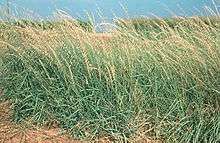Bouteloua curtipendula
| Bouteloua curtipendula | |
|---|---|
 | |
| Scientific classification | |
| Kingdom: | Plantae |
| (unranked): | Angiosperms |
| (unranked): | Monocots |
| (unranked): | Commelinids |
| Order: | Poales |
| Family: | Poaceae |
| Genus: | Bouteloua |
| Species: | B. curtipendula |
| Binomial name | |
| Bouteloua curtipendula (Michx.) Torr. | |
| Synonyms[1][2] | |
|
Synonymy
| |
Bouteloua curtipendula, commonly known as sideoats grama,[3] is a perennial, short prairie grass that is native throughout the temperate and tropical Western Hemisphere, from Canada south to Argentina.
Description

Sideoats grama is a warm-season grass. The culms (flowering stems) are 30–100 cm (12–39.5 in) tall,[4] and have alternate leaves that are concentrated at the bottom of the culm.[5] The leaves are light green to blue-green in color, and up to 6 mm (1⁄4 in) across.[5]
The flowers bloom in summer and autumn. They are grouped in spikes or racemes that are positioned alternately along the top 15 to 25 cm (6 to 10 in) of the culm. There are 10–50 spikes per culm. Each spike contains 3–6 spikelets, or rarely as many as 10. Each spikelet is 4.5 to 10 mm (3⁄16 to 3⁄8 in) long[4] and consists of two glumes and two florets. One of the florets is fertile, and has colorful orange to brownish red anthers and feathery white stigmas during the blooming period, which contrasts with the pale green, pale red, greenish-red, or purple[6] color of the spikes themselves.[5]
After it is pollinated, the spike becomes straw-colored. The fertile florets become seeds, and when they are ripe, the whole spike falls to the ground.[5]
Distribution and habitat
Sideoats grama grows well on mountainous plateaus, rocky slopes, and sandy plains. It is drought- and cold-tolerant and is hardy in USDA hardiness zones 4–9 (average annual minimums of −30 to 25 °F, −34 to −4 °C).
Ecology
It provides larval food for the veined ctenucha (Ctenucha venosa).[7]
Conservation
It is currently listed as a threatened species in the U.S. state of Michigan.
Uses
Sideoats grama is considered a good foraging grass for livestock. It is planted for erosion control.
Cultivation
It is cultivated as an ornamental plant for native plant and drought-tolerant gardens.
Culture
Sideoats grama is the state grass of Texas.[8]
References
- ↑ Tropicos, Bouteloua curtipendula (Michx.) Torr.
- ↑ The Plant List, Bouteloua curtipendula (Michx.) Torr.
- ↑ "Bouteloua curtipendula". Natural Resources Conservation Service PLANTS Database. USDA. Retrieved 10 January 2016.
- 1 2 "Bouteloua curtipendula". Flora of China. Missouri Botanical Garden – via eFloras.org.
- 1 2 3 4 Hilty, John (2016). "Side Oats Grama (Bouteloua curtipendula)". Illinois Wildflowers.
- ↑ "Sideoats Grama (Bouteloua curtipendula)". Prairie Nursery.
- ↑ Soule, J.A. 2012. Butterfly Gardening in Southern Arizona. Tierra del Soule Press, Tucson, AZ
- ↑ "Texas State Symbols". About Texas. Texas State Library and Archives Commission. 2006-11-14. Retrieved 2007-02-01.
External links
-
 Data related to Bouteloua curtipendula at Wikispecies
Data related to Bouteloua curtipendula at Wikispecies -
 Media related to Bouteloua curtipendula at Wikimedia Commons
Media related to Bouteloua curtipendula at Wikimedia Commons